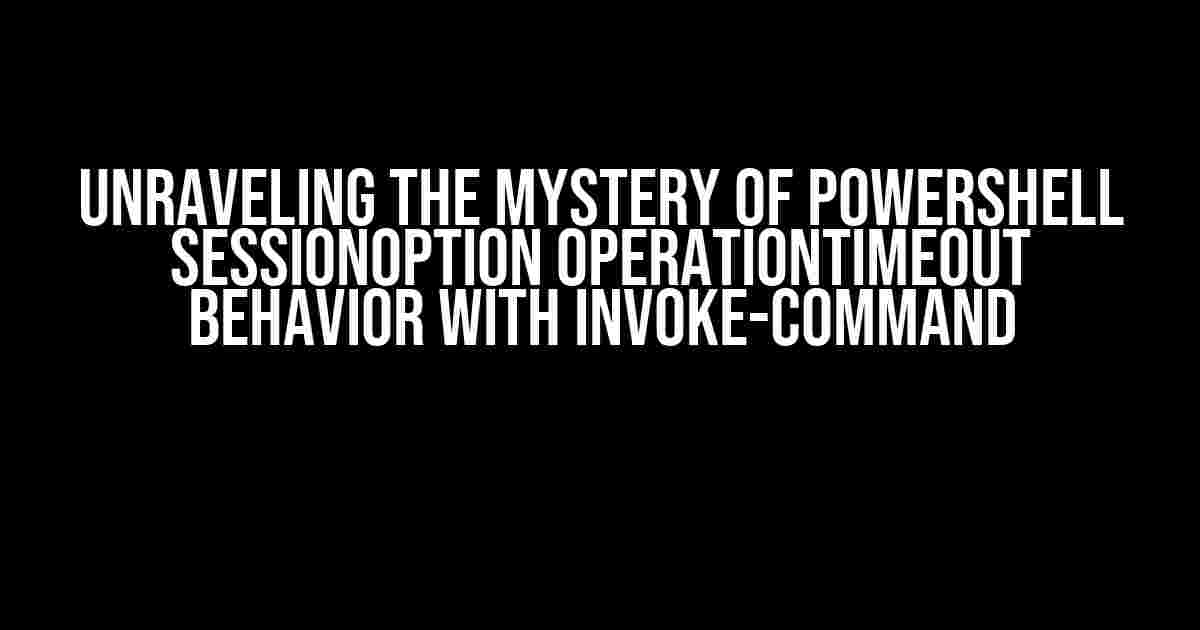Are you tired of dealing with those pesky timeouts when using Invoke-Command in PowerShell? Do you find yourself scratching your head, wondering why your scripts are failing due to mysterious timeout errors? Well, wonder no more! In this article, we’ll dive deep into the world of SessionOption and the OperationTimeout behavior, and show you how to tame the beast and make your remoting scripts run smoothly.
What’s the Deal with SessionOption and OperationTimeout?
In PowerShell, when you use Invoke-Command to execute a scriptblock on a remote machine, it creates a new PowerShell session on the remote machine. This session has its own set of options, including the OperationTimeout value, which determines how long the cmdlet waits for the operation to complete before throwing a timeout error.
By default, the OperationTimeout value is set to 3 minutes (180 seconds). This means that if your scriptblock takes longer than 3 minutes to execute, the cmdlet will timeout and throw an error. But, what if you need more time? What if your scriptblock requires more processing power or has to wait for some external process to complete? That’s where the SessionOption comes in.
Configuring SessionOption and OperationTimeout
To configure the SessionOption and OperationTimeout, you can create a new SessionOption object and pass it to the Invoke-Command cmdlet. Here’s an example:
$so = New-PSSessionOption -OperationTimeout 300
Invoke-Command -SessionOption $so -ComputerName remote_machine -ScriptBlock { # your scriptblock here }
In this example, we create a new SessionOption object with an OperationTimeout value of 300 seconds (5 minutes). We then pass this object to the Invoke-Command cmdlet, which will use the specified timeout value when executing the scriptblock on the remote machine.
When to Use SessionOption and OperationTimeout
So, when should you use SessionOption and OperationTimeout in your PowerShell scripts? Here are a few scenarios:
- Long-running scripts: If you have a script that takes a long time to execute, you may need to increase the
OperationTimeoutvalue to prevent timeouts. - Resource-intensive operations: If your script performs resource-intensive operations, such as large file transfers or database queries, you may need to increase the
OperationTimeoutvalue to allow the operation to complete. - Waiting for external processes: If your script needs to wait for an external process to complete, such as a third-party application or a system service, you may need to increase the
OperationTimeoutvalue to allow the process to complete.
Best Practices for Using SessionOption and OperationTimeout
When using SessionOption and OperationTimeout, keep the following best practices in mind:
- Set the
OperationTimeoutvalue judiciously: Set theOperationTimeoutvalue to a reasonable value that allows your script to complete, but not so high that it causes unnecessary delays. - Test your scripts: Test your scripts with different
OperationTimeoutvalues to ensure they complete successfully and within the expected timeframe. - Monitor your script execution: Monitor your script execution to identify potential bottlenecks and areas where the
OperationTimeoutvalue may need to be adjusted.
Common Issues and Troubleshooting Tips
Despite your best efforts, you may still encounter issues with SessionOption and OperationTimeout. Here are some common issues and troubleshooting tips:
| Issue | Troubleshooting Tip |
|---|---|
Timeout errors despite increasing OperationTimeout |
Check for resource constraints on the remote machine, such as CPU or memory usage. |
| Scriptblock execution takes longer than expected | Optimize your scriptblock to reduce execution time, such as by using parallel processing or caching results. |
OperationTimeout value is not being respected |
Verify that the SessionOption object is being passed correctly to the Invoke-Command cmdlet. |
Conclusion
In conclusion, mastering the art of SessionOption and OperationTimeout is crucial for writing robust and efficient remoting scripts in PowerShell. By understanding how to configure and use these options, you can ensure that your scripts execute smoothly and within the expected timeframe. Remember to test your scripts, monitor their execution, and adjust the OperationTimeout value as needed to achieve optimal results.
Now, go forth and conquer the world of PowerShell remoting with confidence!
Frequently Asked Question
Get clarity on PowerShell SessionOption OperationTimeout behavior with Invoke-Command!
What is the default OperationTimeout value for PowerShell SessionOption?
The default OperationTimeout value is 3 minutes (180 seconds). This means that if your remote command doesn’t complete within 3 minutes, the session will time out and the command will be terminated.
How does the OperationTimeout value affect the Invoke-Command cmdlet?
The OperationTimeout value sets the maximum time (in seconds) that the Invoke-Command cmdlet waits for a response from the remote computer. If the remote command doesn’t complete within this time frame, the command will timeout and an error will be thrown.
Can I change the OperationTimeout value for a specific Invoke-Command session?
Yes, you can modify the OperationTimeout value by creating a new PSSessionOption object and specifying the desired timeout value. Then, pass this object to the -SessionOption parameter of the Invoke-Command cmdlet.
What happens if I set the OperationTimeout value to 0?
If you set the OperationTimeout value to 0, the Invoke-Command cmdlet will wait indefinitely for a response from the remote computer. This is useful for scenarios where you need to run a command that may take an extended period of time to complete.
Can I set different OperationTimeout values for different remote commands?
Yes, you can create multiple PSSessionOption objects with different OperationTimeout values and pass them to the -SessionOption parameter of the Invoke-Command cmdlet for each remote command. This allows you to customize the timeout behavior for each command based on its specific requirements.

